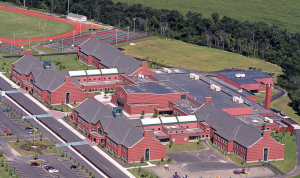Local History

What Did High School Look Like Before Zoom?
by the hillsdale historians
Now that secondary education in the Roe Jan region by Zoom is becoming the exception instead of the rule, it’s worth remembering that for the first 114 years of its existence, Hillsdale had no high school at all. Until 1903, an eighth-grade education had been deemed adequate — the “Three Rs” equipped most people to enter the workforce of the day. But as the economy began to require more and more “white collar” workers, further time in the classroom became a necessity.

In 1903, the New York State Legislature enacted the Compulsory Education Law which extended the age of mandatory school attendance from 14 to 16, where it remains to this day. In the process, “high school” as we know it was born. Prior to 1903, parents who wanted their children to obtain a secondary level education had to enroll them in private academies or institutes, such as the Hillsdale Classical Institute we wrote about here.
Hillsdale High School was located on the north side of the Columbia Turnpike (Rt. 23), approximately 200 yards west of the Civil War Monument.
In the days before school buses were a thing, HHS students often took the train from Copake Falls or Craryville to Hillsdale and walked up the hill to the school. In a 1990 Independent article, Mrs. Mildred Walter shared her memories of commuting to the school, noting that if one was lucky enough to have a boyfriend from Hillsdale, he would meet the train and carry her books to school.
Mrs. Walter did indeed have a boyfriend – Orson Pulver — but alas, these high school sweethearts eventually went their separate ways and Orson ended up marrying a different girl from Hillsdale High School, Helen Barclay. Helen went on to teach at the school.
Hillsdale High School was one of 29 school districts in the area, many of them being one room schoolhouses. As the Progressive era emerged in the 1920s, many educators and politicians felt that these micro-districts should be consolidated into larger centralized schools. That led to the construction of the Roeliff Jansen Central School, which opened in 1932. With all 29 districts incorporated within it, the RJCS district became the largest in New York State.
Whatever became of the building that housed Hillsdale High School?
A man named Roy Van Deusen purchased the building and dismantled it. He used the lumber from the school to construct two houses near the corner of Rt. 23 and Brady Lane.
A sidenote about Roy: Roy Van Deusen was born in 1878. Like so many people of his era, Roy had a lot of jobs over the years. He worked at Pulver’s store for a while, then moved on to be a farmhand. In time, he became a representative of the International Harvester Company, the remains of which are now owned by Volkswagen. He also built and sold houses – the two constructed from the high school, and one other. When he was a footloose 19 year old, he bought a Penny Farthing.
The name Penny Farthing comes from the big wheel in the front in relation to the small one in the rear. To some in England where the bikes originated, it looked like a penny and a farthing next to each other.
A farthing was one-quarter of a penny, the smallest increment of British money. H. D. Harvey, publisher of the Hillsdale Harbinger, had a side hustle selling these bicycles, which were manufactured by the Hartford Bicycle company and commonly known as a “Hartford wheel” or sometimes just “wheel.” Mr. Harvey published the sale of each one in his newspaper as a news item, possibly not the most ethical of journalistic practices.
Anyway, Roy married Edith Gilbert in 1900 and we’re betting his bicycle tomfoolery came to an end.
 Back to the Roeliff Jansen Central School. In 1947, 15 of the 29 districts were hived off to form the Ockawamick Central School district, which included Philmont. Philmont’s most celebrated graduate is Lt. Colonel Oliver North of Iran-Contra notoriety and more recently known for a power struggle at the National Rifle Association.
Back to the Roeliff Jansen Central School. In 1947, 15 of the 29 districts were hived off to form the Ockawamick Central School district, which included Philmont. Philmont’s most celebrated graduate is Lt. Colonel Oliver North of Iran-Contra notoriety and more recently known for a power struggle at the National Rifle Association.
In 1962, the Roeliff Jansen school completed an expansion (seen on the left side of the photo) that nearly doubled its footprint. Meanwhile, due to its academic rigor and high standards in general, RJCS graduates routinely attended Ivy League and other renowned colleges.
In 1970, the Taconic Hills Central School district was formed, leading to the reunification of the Roeliff Jansen and Ockawamick districts. In 2000, the Taconic Hills district moved into a $50 million campus in Craryville, and the Roeliff Jansen school was abandoned.
Recent press reports suggest that the abandoned Roe Jan school building may find a new life as a resort, but if you look at this clandestine video of the building from a couple of years ago, those who would take that project on would have their work cut out for them.
In the meantime, we send our heartiest congratulations and best wishes to the members of the Taconic Hills Class of 2021 for getting through the pandemic and moving into whatever the future holds for them.
Follow the Hillsdale Historians and see their latest blog posts as well as past stories by signing up here.


